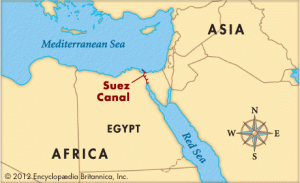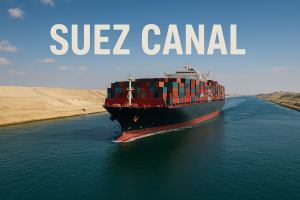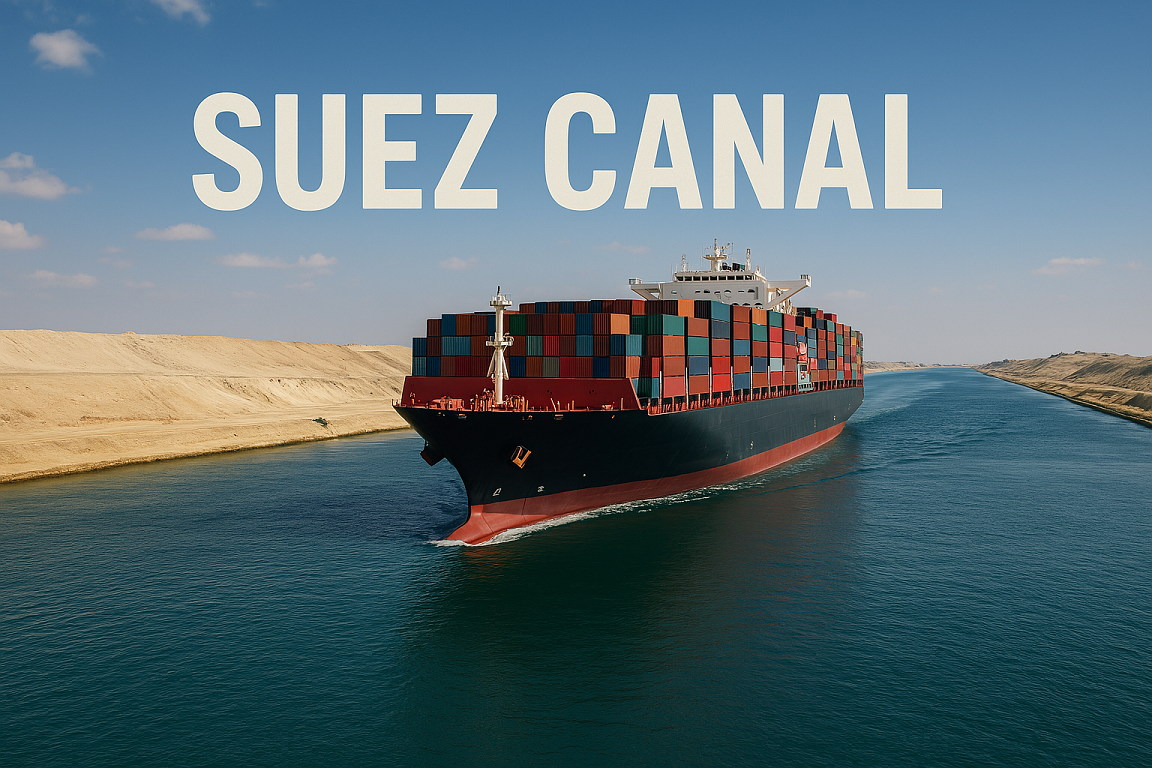04/13/2025
Explore the major events that impacted the Suez Canal in 2024—from Houthi rebel attacks and Red Sea tensions to traffic decline, environmental costs, and future modernization projects. A must-read for maritime professionals, students, and global trade enthusiasts.
The Suez Canal, spanning 193 km (120 miles) through Egypt, serves as one of the world’s most critical shipping shortcuts, connecting the Mediterranean Sea to the Red Sea and eliminating the need for vessels to navigate around Africa. This man-made maritime superhighway handles 12% of global trade, including 30% of container traffic, making it indispensable for oil tankers, LNG carriers, and cargo ships traveling between Europe, Asia, and the Middle East.
Recent expansions, including the 2015 New Suez Canal project, have doubled capacity, allowing two-way traffic and reducing transit times. However, disruptions like the 2021 Ever Given blockage (which cost global trade $9.6 billion per day) highlight its vulnerability. Today, the canal remains a geopolitical hotspot, with rising toll fees and alternative routes (such as the Cape of Good Hope) gaining attention amid regional tensions.

A Global Artery Under Pressure
The Suez Canal remains one of the world’s most strategic maritime chokepoints, where global trade meets geopolitics. As the fastest sea route between Europe and Asia, it gives Egypt immense geoeconomic leverage, generating over $7 billion annually in toll revenue. Control over this vital passage influences energy security (30% of global LNG shipments transit here) and global supply chains, making it a focal point for international tensions. Recent Houthi attacks in the Red Sea and the 2021 Ever Given crisis have exposed how disruptions here can trigger shipping delays, oil price spikes, and inflation worldwide. Major powers, from the US to China, closely monitor this 100-mile corridor that carries more economic value than any other artificial waterway.
Facilitates around 12% of global trade, this narrow waterway ” Suez Canal ” is a critical maritime shortcut linking the Mediterranean Sea to the Red Sea. In 2024, however, this vital passage faced unprecedented disruption, sparking concerns across the global shipping industry. Traffic dropped by over 60%, environmental costs soared, and geopolitical tensions put shipping companies on high alert. Let’s explore how the Suez Canal crisis unfolded in 2024, its far-reaching effects, and what lies ahead.

⚠️ Houthi Attacks and the Red Sea Crisis
What Happened?
The Houthis, a Yemeni group, have targeted commercial ships they response to the war in Gaza. These Red Sea disruptions aim to pressure US, though many affected vessels have only indirect or unclear connections. The attacks have triggered international security concerns, leading to increased naval patrols and rerouted trade. In early 2024, Yemeni Houthi attacks on commercial vessels in the Red Sea—primarily in solidarity with Palestinian civilians under the bombardment—sparked a major crisis.
-
Impact: Shipping companies diverted routes away from the Red Sea, reducing daily Suez Canal traffic from 75 ships to just 32.
-
Security concerns prompted rerouting around the Cape of Good Hope, adding 11+ days to each journey.
📈 Top search in 2024: “Houthi attacks on ships – Red Sea impact”
📉 Suez Canal Traffic Decline and Revenue Loss
-
Daily ship transit fell by over 60% compared to 2023.
-
Egypt’s canal revenues dropped by $7 billion, a substantial hit to its national income.
-
Key industries—especially energy, food, and e-commerce logistics—felt the impact globally.
| Year | Average Ships per Day | Revenue |
|---|---|---|
| 2023 | ~75 | $11.6B |
| 2024 | ~32 | $4.6B |
💸 Economic & 🌱 Environmental Consequences
Economic Ripple Effects:
-
Increased fuel costs due to longer routes
-
Delays in global supply chains, particularly in the energy and agriculture sectors
-
Rise in insurance premiums for vessels passing through high-risk zones
Environmental Toll:
-
Ships rerouted via the Cape of Good Hope emitted significantly more CO₂
-
Estimated carbon emissions rose by 3–4 million tons in 2024 due to detours
🌎 “Environmental cost of Suez Canal disruption” ranked among top 5 shipping-related searches.
🛠️ Modernization & Expansion Efforts
To avoid future bottlenecks like the Ever Given incident in 2021 and increase resilience, Egypt launched an $8 billion expansion project in 2024.
Highlights:
-
Widening of the Great Bitter Lake section
-
Creation of a second, parallel lane
-
Goal: Increase capacity from 50 to 85 ships/day
🔧 This initiative aims to restore confidence among shippers and reduce the canal’s vulnerability to blockages.
🌐 Geopolitical Tensions: The Middle East Maritime Maze
-
The Gaza genocide intensified instability in the region.
-
Houthi attacks targeted Red Sea lanes.
-
U.S. retaliatory strikes in Yemen escalated tensions further in early 2025.
The geopolitical web made the Bab el-Mandeb Strait, which links the Red Sea to the Gulf of Aden, one of the world’s most dangerous maritime chokepoints.
🔮 Future Outlook: Will Traffic Recover by 2025?
There’s hope on the horizon:
- Military coalitions, including Operation Prosperity Guardian, aim to secure sea lanes.
-
Analysts project traffic recovery by Q4 of 2025, assuming regional peace holds.
📊 “Projected recovery in Suez Canal traffic 2025” has become a trending maritime query.
📌 Most Searched Suez Canal Topics in 2024
- Houthi Attacks on Ships (Red Sea security crisis)
- Suez Canal Revenue Losses (60% decline)
- Alternative Shipping Routes (Cape of Good Hope)
- Suez Canal Expansion Project
- Environmental Impact of Longer Routes
- Geopolitical Tensions & Maritime Safety
- Forecasts for Canal Recovery in 2025
❓ FAQs – People Also Ask
❓Why did traffic through the Suez Canal drop in 2024?
Due to Houthi rebel attacks in the Red Sea, many vessels avoided the Suez Canal and were rerouted around Africa.
❓What is being done to protect ships in the Red Sea?
International naval coalitions have deployed warships to protect commercial vessels under Operation Prosperity Guardian.
❓How did rerouting affect the environment?
It increased transit distances by thousands of kilometers, significantly raising CO₂ emissions and fuel usage.
❓What is the goal of the Suez Canal expansion?
To increase ship capacity, reduce congestion, and prevent disruptions from future incidents or blockages.
🧭 Conclusion: Charting a Resilient Course Ahead
In 2024, the Suez Canal reminded the world of its strategic and economic significance. As geopolitical risks reshaped shipping lanes, the maritime industry faced tough lessons in resilience, adaptability, and sustainability.
The coming year holds cautious optimism: expanded infrastructure, greater security coordination, and diplomatic breakthroughs could restore the canal’s place at the heart of global trade.
🌐 Stay ahead of maritime disruptions and updates at MaritimeEducation.com

